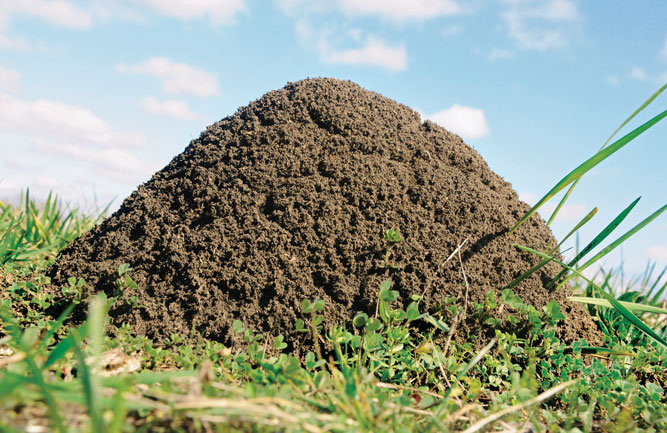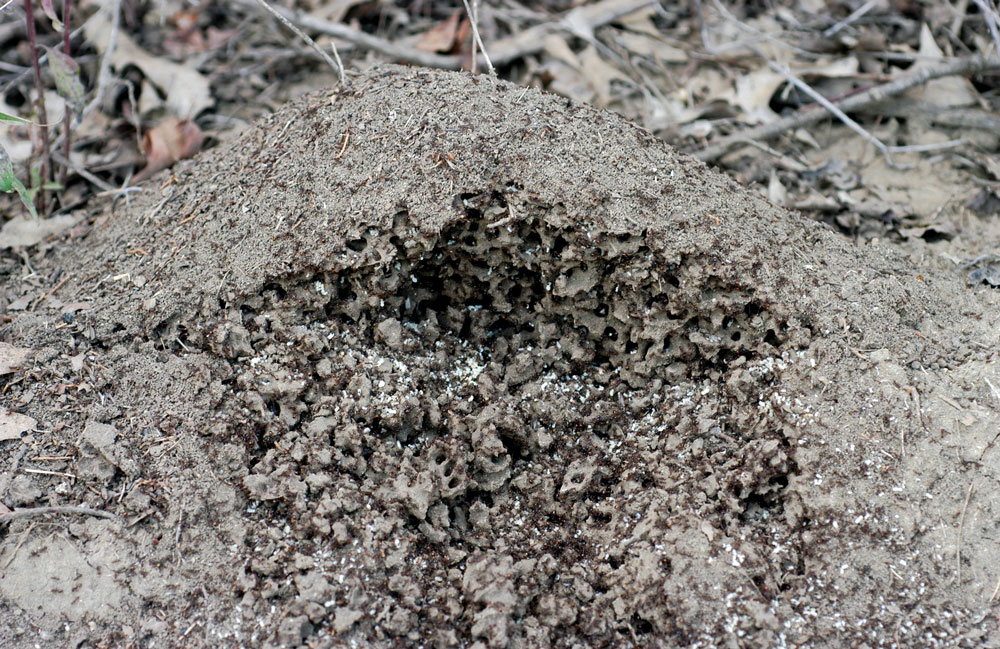Expert tips on how to not get burned by fire ants on the course

The iconic fire ant mound is a surefire way to spot the pest on your course. The mound won’t have any visible entrances. (Photo: Blake Layton, Ph.D.)
Fire ants are the No. 1 pest affecting courses in the southeast U.S., according to Blake Layton, Ph.D., Extension entomology specialist at Mississippi State University.
The ant’s mounds are easy to spot; they commonly appear as large mounds with no visible entrances. Fire ants prefer to set up colonies in low-play areas, like the rough or up against a sidewalk, but superintendents can occasionally find them on a green or a high-traffic area.

Blake Layton, Ph.D.
“If an area is mowed and disturbed, they’ll just quit heaping that soil up and live down in the soil,” he says. “So, you can still have a colony even on your green or someplace like the tee box.”
While fire ants don’t damage turf, the pest’s mounds can hurt equipment like mowers and be an issue with their aggressive nature.
“Mowing through those mounds can be an issue,” Layton says. “But really, it’s their unsightliness and the fact that they sting. Nobody wants to play a ball that landed in a fire ant mound on a fairway.”
Fire ant control hasn’t changed much in recent years, Layton says. There are several baseline ways to control the pest using broadcast insecticide treatments — like bifenthrin and fipronil — either in a problem area or directly to the mound and granular bait.
“Granular baits can be used as an effective baseline control,” says Layton. “Bait alone won’t give you 100 percent control. You also need broadcast treatments where you’re putting insecticides down to kill workers that are foraging.”

A fire ant mound can not only be an eyesore on the course, but if disturbed, it could lead to fire ants becoming aggressive. (Photo: Blake Layton, Ph.D.)
As for timing, Layton suggests four applications of bait throughout the year, twice in the spring, once mid-summer — around the Fourth of July — and another in the fall. Superintendents can use broadcast treatments as needed, but Layton says most applications should occur in the spring as soon as fire ants become active.
“That (fall bait application) will help to make sure that when the course opens back up in the spring, you won’t have an infestation of fire ant mounds,” he says.

Brittany Campbell, Ph.D., B.C.E. (Photo: Quali-Pro)
Quali-Pro
Brittany Campbell, Ph.D., B.C.E.
Technical service manager
There is no good way to prevent fire ant infestations on golf courses, but there are strategies for controlling them once they become established. Broadcast bait applications are one of the best control methods for fire ant control. For this method, granular baits are spread across an area, and foraging fire ants find the bait and take it back to the colony, where it is shared among nest mates and the queen. Another method is individual mound treatments, but these treatments only control the mound where the application is applied and will not affect other mounds in an area. For broadcast bait applications, the first application should be in the spring and then a follow-up application in the mid-summer or fall.

Jen Browning, PCA (Photo: BASF)
BASF
Jen Browning, PCA
Technical service specialist
The easiest way to control native and imported fire ants is with insecticide fire ant baits like Siesta. This material is a highly attractive bait matrix formulated specifically for fire ants. Baits let you spot-treat mounds or broadcast onto larger areas safely and easily without risk of bites and stings: the ants do the work. Worker ants take the bait back to the nest and distribute the insecticide, feeding the colony and queen. Within days, the colony dies.

Lane Tredway, Ph.D. (Photo: Syngenta)
Syngenta
Lane Tredway, Ph.D.
Technical services manager
Several products are available for fire ant control via broadcast applications or individual mound treatments. Mound treatments with contact insecticides work quickly but often fail to provide complete control. Broadcast application of systemic insecticides or IGRs provides more complete control but takes weeks to kick in fully. Advion fire ant bait is a unique product that provides both rapid and long-lasting results, with complete colony control within 72 hours and season-long control with just two applications. Syngenta recommends a broadcast application in the spring (April-May) and a second in late summer to fall (September-October) for season-long control of fire ants.

Brian Mount, M.S., B.C.E. (Photo: FMC)
FMC
Brian Mount, M.S., B.C.E.
Technical service manager
Golf course superintendents can control fire ants by using residual insecticides, such as Triple Crown Golf, as broadcast treatments or spot treatments to mounds or by utilizing baits in the same manner. Insecticides are most effective when temperatures are higher in late spring and summer when ants are more active and likely to contact the treatment. Broadcast insecticide treatments will help control ants that are present today and those that may fly in later. Mound treatments will only control the mounds that are directly treated. Broadcast bait treatments are also a good option where foraging ants pick up the bait and bring it back to the colony, ultimately killing the queen.












